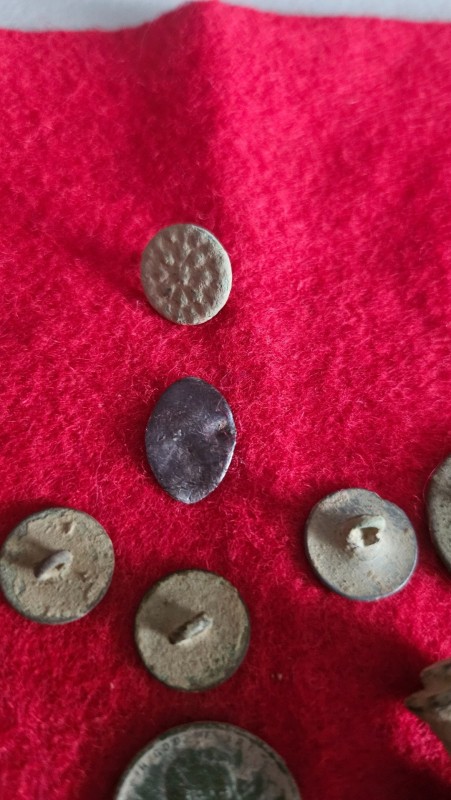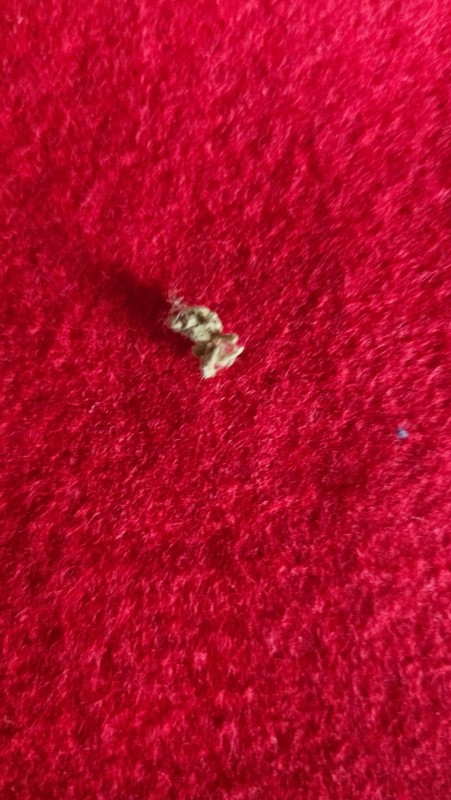-
Posts
6,111 -
Joined
-
Last visited
-
Days Won
32
Content Type
Forums
Detector Prospector Home
Detector Database
Downloads
Everything posted by Chase Goldman
-
If your lowest tone break is at 0.0 it means you have disc at 0. Adjusting tone breaks on this menu just enables you to select different volumes for up to four different portions of the ID scale (the ferrous region below the discrimination tone break is controlled by the iron volume setting). It doesn't change the pitch or actual tone breaks per se as you are in full tones. I would not have changed it from the 4 default non-ferrous tone breaks unless you want to emphasize or deemphasize the volume of specific ID regions. Frankly, I am not seeing any reason to set up the FT breaks the way you have done it here, it doesn't appear to serve any useful purpose.
-
Correct - that's what I was referring to in my discussion of Sens FT, you said it more clearly. I also want to mention that how you set up your other audio parameters is key and needs to be customized for your hearing and comfort. I like PCM audio because though it is somewhat harsh to those not used to it, I like the tonal nuances it conveys. But Hi-Square audio is a suitable compromise that combines a lot of the tonal nuance of PCM with the more musical sounding tones of Square. The audio filter can also being out more tonal nuance at high settings, enhancing the tonal distortions associated with overloaded target signals like aluminum can tops or the sonic harmonics of jagged targets like can slaw. Use the Equalizer to compensate and boost frequencies that are attenuated due to hearing loss or fidelity shortcomings in your headphones/earbuds/speakers. Finally, adjusting Audio Response is key depending on your hunting style or target objectives. Adjust it to lower numbers if you want to be consciously aware of deeper fainter targets (if you are ignoring shallow recent drops for example) or set it higher if you want to be assured of hearing targets that are on the edge of detection.
-
First of all, going full negative disc and/or full tones does not increase the performance (depth, responsiveness, TID accuracy) of the D2, per se. Some people prefer those settings because it can enhance audio for some targets (see my next paragraph) and/or it gives you a more audible cue when swinging over low, medium, or high conductors without having to rely on displayed TID. Going full negative disc merely means you are going to pick up ground targets/feedback and perhaps some brick or ceramics. That's fine if you're specifically looking for concentrations of such materials as telltale indications of a former structure or former human presence, but mostly you are just going to hear a lot of ground feedback. If you increase discrimination to above 0 (I like to keep mine around 7 to 10) you can discriminate most iron but can still hear it via the iron volume setting. (Iron concentrations are a more reliable telltale of newer former wooden structures that used nails or former human presence in general by the iron tools and implements left in the ground). Applying discrimination as noted in the recently linked XP video on identifying ferrous does not impact performance, so there are really very few reasons not to use it. There are other potentially less tangible benefits to using discrimination related to horseshoe indicator stability and TID down averaging but those "benefits" are subject to debate because that was the case with the Deus 1 but XP has not been clear in this regard for Deus 2. Related to Full Tones and setting Disc, XP fixed a Deus 1 and pre-D2 version 1.0 flaw that didn't allow Iron Volume to work with Full Tones and applied Discrimination above 0. That's been fixed now with v1.0 and later and you can get iron volume in Full Tones below the Disc breakpoint and you can set up tone pitch separation between the lowest pitched tone in Full tones and Iron Volume pitch by adjusting the "Offset" expert setting in the Disc expert submenu. Regarding Full Tones - Like I said previously, it's a matter of ear preference. It gives a more fluid audio that is correlated directly to target ID (rather than target strength, like pitch or the discrete 2,3,4,5 multitones which are more stable but less nuanced) which also audibly alerts you to targets with variable TIDs or multiple targets of different IDs under the coil mimicking visual ID variations. If you're trying to simply distinguish ferrous from non-ferrousIand and not prospecting, I highly recommend either using pitch tones with some Disc and Iron volume applied in General, Sensitive, Sensitive FT (Sensitive FT has a unique and different (more aggressive) silencer Filter compared to the other modes, including Sensitive and Fast. You can change FT to pitch tones or multi-tones in the Sens FT program despite its name), or Deep HC or Relic with some IAR (Relic/Goldfield's different take on Disc - I recommend setting it at 3 or 5). If using Relic, be sure to notch out 00 as that is usually just ground feedback but it manifests as a non ferrous tone. Annoying but 00 fixes that right up. I suggest trying FT or Pitch to see which works better for you. If you prefer to simply be alerted to faint non-ferrous in the presence of ferrous, I like pitch with a high Audio Response setting, though you do have to rely on TID for a dig decision if you are "visually" discriminating out low conductive non-ferrous or only have a specific target ID range of interest and/or you can also "interrogate" the target with a FT program variant to help you decide. I keep a FT General custom program in an adjacent program slot to my custom Relic program so I can quickly alternate between them on the fly or when interrogating a target. Alternatively, you can use FT if you want to listen for target ID stability that can tell you if you may have irregular target shape or multiple materials (perhaps junk) or simply want to detect with less reliance on glancing at visual TID. Both Pitch and FT give you A LOT of nuanced audio target information - a lot more than you can glean just from visual TID with Multi-tones. HTH
-
Yes. I have a beach water rig set up using the excellent SteveG CF shaft system because I only use one coil for that system (I split the difference using an 11" coil) and then I don't have to break it down and mess with the antenna etc. and have just my Beach/Water custom programs entered. I primarily use the stock shaft setup for land hunting with my relic and coin shooting custom programs entered in and swap 9" and 13" coils as needed for the situation. I just swap remotes if I want to use the CF water rig on land or if relic hunting freshwater inland waterways and land during a single outing. Look for deals on lightly used units for sale that periodically pop up in the DP classifieds or elsewhere online. The 5 year warranty transfers.
-
...or your pick or shovel.
-

Avantree Interested In Hearing From You
Chase Goldman replied to Wiggins's topic in Detector Prospector Forum
You ask a dozen people and you are going to get two dozen preferences. I like to think about a request like this more globally instead of shutting down certain options because of my own personal preferences (for example, some need the noise isolation and comfort in extreme hot or cold environments that earbuds or over the ear headphones provide while others need situational awareness and comfort, hence bonephones or a neck speaker). Different stokes for different folks, all valid. Therefore, I think the best approach by Avantree would be to provide choices or products like a rugged Torus unit that can get wet and provide the option between isolation or situational awareness and recognize that some users will require multiple products depending on the type of detecting they are doing and when/where they are doing it. For example, some may wear bone phones in the summer and over the ear phones in winter. Stepping away from form factor, it's clear there are some essential characteristics needed for metal detecting wireless audio products: Low Latency (lowest possible), strong wireless signal not subject to dropouts due to wireless device placement, devices that do not introduce additional detector EMI, devices with good fidelity and dynamic range and a large adjustable range for volume (having a way to quicky mute the output is a bonus), physically rugged, water/dust resistant, long battery life and quick refresh recharging, integrated loudspeaker or modular speaker add-on options, and jacks to provide wired headphone/speaker capability or ability to convert the wireless phones into wired phones, universal physical connectivity, multiple device connectivity/multi-point (ability to connect a single headset to different devices at the same time to accommodate wireless detectors and pinpointers as well as to accommodate switching Detectors in the field without having to also switch your wireless audio gear). I envision a metal detector centric wireless audio eco system with the above features and capabilities incorporated across a line of devices that are compatible with each other, as needed, including: A weatherproof and low profile and Low Latency transmitter that can be easily plugged into any detector headphone jack without worrying about it getting wet, flopping around, getting tangled on brush etc. Something that has physical protection, barely protrudes from the jack but that can be easily grasped for removal. I should have all day or multi-day battery life (this goes for all the devices below, as well). A low latency receiver that can accept any wired headphone plug (even USB C audio plugs), that is rugged and weatherproof with appropriate physical attachment points (or a holder or case) to enable it to be placed wherever you want it and a provision for an external speaker or a detachable speaker module. A rugged Torus like Neck Speaker with built in Buds like Torus that can also survive an occasional soaking. Aux in/out ports would be a welcome feature too. Neckband earbuds with no controls hanging off the bud wires. Waterproof Full Size wireless phones that can be used in wired mode and muted or switched between two receivers (can be used with multiple wireless accessories such as detector and pinpointer) as well as wireless multipoint. Low latency wireless bone phones or air conduction phones with multipoint. Perhaps a set of compatible true wireless IP rated Buds.- 78 replies
-
- 4
-

-
- minelab gpz 7000
- headphones and audio
-
(and 1 more)
Tagged with:
-
I think a good addendum to this video would be techniques to handle thick iron patches. Lowering sensitivity, increasing reactivity, and potentially making extreme adjustments to silencer and b-caps are all adjustments that can help in that situation. Lowering sensitivity to decrease iron overload and increasing reactivity are straight forward methods to increase detection of shallow non-ferrous hiding between the ferrous targets (yes, you are trading off depth for detectability/separation in this situation - adjust your expectations for the reality that there are no free lunches). Applying Silencer and B caps filters are less intuitive and straightforward and require some trial and error experimentation.
-

New Garrett Detector In 2024
Chase Goldman replied to Bill (S. CA)'s topic in Garrett Metal Detectors
What's a ML 7000? Are you referring to the GPZ 7000? Regardless, in jest you are actually making a good point. Induction Balance detector technology has plateaued in terms of raw performance (depth, speed). IDs are pretty good and stable (D2's IDs are amazingly stable in mild ground). Perhaps there is room to improve with adaptable/learning technologies applied to target signal processing such that one of the hobby detector holy grails actually becomes consistently achievable...namely differentiating aluminum from gold targets (not talking prospecting here) or aggressive EMI cancellation. Other than that, increases in raw performance need the application of a new detection method that is practical for field use in a manner detectorists are used to and at depths from which it is practical to actually recover targets without a backhoe. -

New Garrett Detector In 2024
Chase Goldman replied to Bill (S. CA)'s topic in Garrett Metal Detectors
They could just drop the price and perhaps do a feature refresh with a firmware update to minimize further investment in R&D and manufacturing line changes for the Apex consistent with the competition. The next step would be to make it submersible but that would require more significant changes to the enclosure and headphone ports. Probably not worth the trip, though, as they are just getting repeatedly lapped in the low price arena by ML and especially by Nokta with the SMF Score/Double Score. I guess what I was saying was at the time it was released it was price competitive for the feature set it offered up but it never quite made a big splash because its performance was just ok and has not aged well since because of everything else that Garrett's competitors have released. And now it seems like Garrett shouldn't bother further trying to wedge itself in to that market segment unless they are going to offer some sort of ridiculous price point or simply cut Apex's price as I discussed above. But whatever this new Garrett offering is, it needs to make a big splash on the high end and offer something no one else is presently doing. -

Avantree Interested In Hearing From You
Chase Goldman replied to Wiggins's topic in Detector Prospector Forum
You are correct about the phones pictured, but my understanding from Avantree's post was Avantree was simply offering those existing FS/SBC neckband phones up as a visual stand-in for a future BT LE variant Avantree is considering with the same form factor in order to gage detectorist interest in that form factor, so I think that's what Redz was responding to. Regarding that form factor - I like neckband style as it captures the buds in the event one falls out in the field (vs. true wireless), but I like all the controls to be limited to the neckband itself. I dislike control modules hanging off the earbud wires. It makes them feel unbalanced and regardless of how light and compact those modules are, they inevitably tug on the earbud and tend to dislodge it, especially if you are fiddling with the the control module to adjust a setting which is annoying and distracting.- 78 replies
-
- 3
-

-
- minelab gpz 7000
- headphones and audio
-
(and 1 more)
Tagged with:
-

New Garrett Detector In 2024
Chase Goldman replied to Bill (S. CA)'s topic in Garrett Metal Detectors
Not sure why they would make ANOTHER SMF Ace with the Ace Apex already out there (The Ace line is synonymous with entry level). Perhaps a firmware update for the Apex is in the works as many have been wanting for years, but I don't think that would qualify as an exciting new offering from Garrett. It's probably something more ambitious to update the aged AT lineup building on an improved SMF platform from the Apex with multiple SMF profiles (not just multiple discrimination profile presets as with the Apex and salt vs. Land SMF modes), adjustable recovery speeds, submersibility, and a full range of accessory coils available on the same day the unit is released for sale. But it's crowded out there in both the mid/high and low market segments with Equinox/Manticore, Deus 2, and Legend/Score all vying for the low/mid/high end SMF detector market share. And with Xterra Pro and Simplex clogging up the entry level segment with low profit margins I doubt Garrett woukd even try to undercut their own Apex (which until the original Legend price dropped and Xterra Pro came out was the cheapest selectable single frequency machine you could buy), Garrett has their work cut out for them to make a splash and gain a foothold. No easy feat. So it is also a possibility they may swing for the fences and attempt something with high end capability and advanced features - perhaps something that eclipses ML or XP in visual or audio target tech (e.g., leveraging and updating the Spectra graphics IP they now own, incorporating long lost features such as true All Metal and/or mixed audio modes) or incorporating machine learning or AI aspects into the platform to enhance versatility. -
Good video. Very thorough - premptively answers a lot of repeatedly asked questions I see and respond to here on the forum. I'm going to point folks to it next time questions come up regarding iron. Can't disagree with anything covered in that video. I love Gary, but am glad XP is also using other folks to provide D2 tutorial information as well.
-
This RC Digs cage is exactly what you need for diving.
-
While I like some of DD's products (the XP compatible headphones he sells are great as well as some of the other 3D printed accessories) there are two issues in play here. First, the XP design of the mount is fundamentally flawed because the objective to provide a mount that enables quick attachment and removal of the remote also results in high stress concentrations that cause the mount to gradually lose its ability to maintain a secure grip on the remote and eventually results in mount failure regardless of the material used (but some 3D printed materials are especially ill suited for this application - see Brad's pic). Second, applying bandaids such as locking levers, lanyards etc. to address the degrading secure grip issues don't really reduce the cyclic stresses (from constantly mounting and removing the remote for charging/storage etc.) that eventually causes failure (though some of these bandaids may reduce the number of "unnecessary" re-mounts resulting from the remote simply falling off the mount after being bumped while detecting). The real solution is to move completely away from the design altogether, and that's what the RC Digs cage accomplishes for a cost not much higher than purchasing a replacement XP or third party version of the original design (and certainly lower than multiple XP mount replacements over the lifetime of the rig). I like the RC Digs design, but have yet to put it through its paces. You lose the quick removal capability, but taking an extra 30 seconds to undo two thumbscrews for mount security and longevity is a small price to pay.
-

Is It Just My Impression? Coil Impact
Chase Goldman replied to raziel900's topic in XP Deus II Forum
Good question but for me it happens to me in Relic mode which does not have the ground stabilizer setting and in other modes with stabilizer set at 2. My hunting partner @F350Platinum has experienced increased coil bump sensitivity as well with V2.0 and he never runs Ground Stabilizer 1 because of the additional noise it introduces independent of coil bump sensitivity. Bottom line, most of the people I personally know who are experiencing coil bump sensitivity in V2.0 with the GS set at 2, not because they have it set at 1. But if I was having coil bump sensitivity issues, I agree that running GS at 1 is probably not a good idea. -
It started out looking more like an epic slog for me (but that was the expectation we set for ourselves since we were hitting the fringe areas). Reviewing the track, I didn't find my first keeper, a ragged flat button until 2.5 hours into the 5 hour hunt, then the floodgates opened and it was literally off to the races for us. Maintaining a positive attitude and trusting the plan paid off. Good times. Thanks for the meetup, my friend. Now we know where all those buttons we knew were there somewhere, were hiding. Can't wait for the next adventure.
-
After wrapping up my last 3 Virginia relic hunts of 2023 with a Colonial silver cufflink, a 1944 Merc and a 1793 2-Reale was hoping to keep my silver streak alive in my first hunt of 2024. Met up with Bob again to pillage Virginia beanfields and kept that silver streak alive with my second keeper of the day, another silver cufflink. This one is a little less fancy and tarnished, and not a Cob (congrats Bob), but silver is silver and I'll take it. In addition, snagged A LOT of small Colonial flat buttons, some with backmarks and one with a flower pattern. One shank still had some thread material still attached! A brass plate of some sort but with no markings, a collar stud, brass drawer pull, a couple plow mangled buckles and other miscellaneous brass, saddle studs (one with a fancy design), a lead ingot, '27 Wheatie.. All in all, a great start to 2024.
- 9 replies
-
- 20
-

-

-

Is It Just My Impression? Coil Impact
Chase Goldman replied to raziel900's topic in XP Deus II Forum
Well you’ve asked that question 3 times now in the thread, so apparently no one precisely knows the answer because it’s one of those “it depends” situations due to the number of variables involved. I don’t know the EXACT performance decrement in 3 either, I just know there would be some decrement as it is just another ground filter. Always keep mine at 2 if I’m using a mode that supports it at all - note that I mainly hunt in relic mode which does not have that setting in the GB menu. If I am in mild ground, I usually don’t even bother ground balancing/ground grabbing in relic mode. I notice that when I do a ground grab and the ground phase setting adjusts down from the default to match measured ground phase there is a slight increase in coil bump sensitivity and I have not really noticed a performance decrement in practice (note this is the opposite of what @Jeff McClendonobserved but he is adjusting GB from the default to actual in mineralized ground in his case vs. mild ground in my case, so I believe that is the reason for the different coil bump sensitivity with GB adjustment observations - but TBH I really don’t sweat it even when dealing with crop stubble because I can hear actual targets plainly by doing a re-swing, so I haven’t done any deep dive testing to fully characterize it). For that reason, unless I am getting A LOT of ground feedback, I just leave GB at the default setting…in relic mode. Why don’t you just run a simple a/b test: Place a test target in the ground near the typical or desired limit of detection depth in your soil with the detector Ground Balanced at stabilizer 2 and simply switch it to 3 to see how much the signal degrades, if at all. -
To answer your question more directly, the Deus 2 has a Magnetic ground accept/reject toggle setting in the ground balance menu of the beach modes only but @midalake, if I recall correctly, finds it to not be very useful and it ends up, for him, severely limiting depth performance in reject mode. I know that was the case pre-Version 2.0 Deus 2, not sure if he has fiddled with that setting since loading V2.0. He’ll probably chime in to clarify that.
-
What adjustments, if any, have you made from the default settings for audio (PCM, Square, High Square), the Audio Filter, tones (full, multi (2 through 5 tones), pitch , and salt sensitivity? You run Nox in horseshoe mode, do you run D2 in 0 Disc, negative disc? If D2 had a gold field/relic mode with salt handling it could possibly be better with black sand. I find relic to be the best mode for hot dirt, but it has no salt handling capability. I think Nox ground tracking is superior than D2 for rapidly shifting salt concentrations in surf/wash.Wash. I haven't played with the magnetic reject ground setting since ver 2.0 was issued, but it doesn't seem to do anything but limit non-ferrous depth with or without black sand present.
-
Agree. Conversely, in neutral soils (no salt, no mineralization), top end PI's have minimal depth advantage over top end VLFs like the Manticore or Deus 2 on coin or ring sized targets. So the OP's results are not surprising at all and wouldn't be surprising for many high end vlfs (i.e., the Manticore is not unique in this regard).
-

Looks Like M8's And M15's Are Starting To Appear
Chase Goldman replied to phrunt's topic in Minelab Manticore Forum
They should sell like hot cakes now. Good move Minelab! Marketing geniuses! -

Wm 09 Wireless Audio Module For Manticore
Chase Goldman replied to abenson's topic in Minelab Manticore Forum
The hard copy documentation actually included in the WM 09 package appears to be updated from the above and makes no mention of the WM 09 module being waterproof. That highlighted bullet text above does not exist. Based on that, the statement on the web page, and the fact that the WM 08 is also not waterproof, I conclude the WM 09 neither waterproof or weatherproof. -
I think he was specifically talking about the fact that this setup allows you to zip tie the WS6 holder to the mount. Although the mount will accommodate a remote, there is no obvious way to zip tie the remote to this (or any other) mount unless someone came up with a moulded mount that enclosed the remote like the WS6 holder does. Hmm...that would be a great idea.










